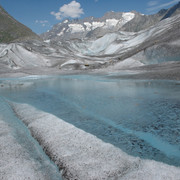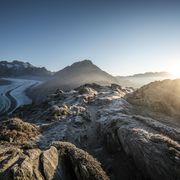How would you like to arrive?
Download GPX file
- 1:45 h
- 4.78 km
- 270 m
- 272 m
- 1,328 m
- 1,484 m
- 156 m
- Start: Blatten bei Naters
- Destination: Blatten bei Naters
The circular hike first leads to the Gibidum reservoir. The Gibidum reservoir with an area of 21 hectares (about 29 football fields) was completed in 1967 and is fed by the Great Aletsch Glacier. You can access the reservoir via a steel staircase. On the way back, the hike takes you through the mystical Rischinerwald forest. Let your gaze wander and enjoy the peace and quiet.
Good to know
Best to visit
Directions
Route description
Blatten bei Naters - Gibidum reservoir - Rischinerwald - Blatten bei Naters
Tour information
Familiy-Friendly
Loop Road
Equipment
Directions & Parking facilities
From western Switzerland: A9 Lausanne - Vevey, or north-western Switzerland: A12 Bern - Vevey: A9 - Sierre: main road Sierre - Brig
From north-western Switzerland: A6 Berne - Thun - Spiez: main road Spiez - Kandersteg (Lötschberg tunnel car transport) - Goppenstein - Gampel - Brig
From eastern and central Switzerland: Andermatt - Realp (year-round Furka car transport; in summer via Furka Pass) - Oberwald - Brig
From Ticino (in summer): Airolo - Nufenenpass - Ulrichen - Brig
Or via Centovalli - Domodossola - Simplonpass - Brig
From Italy (Aosta, Mt. Blanc Tunnel): Aosta - Grand Saint Bernard tunnel (over the pass in summer) - Martigny: A9 motorway - Sierre: Sierre - Brig main road.
Or via Domodossola - Simplon Pass - Brig
Blatten bei Naters
From Brig you can reach Blatten bei Naters via Naters, then take the cable car to the car-free Belalp.
You can find more information at:
You can find the timetable and further information on how to get there at: www.belalp.ch
Additional information
Belalp Bahnen AG
Blatten - Belalp Tourismus AG
Author´s Tip / Recommendation of the author
Enjoy the Rischinerwald and have a picnic.
Safety guidelines
Especially in autumn, you should also be aware that leaves lying on the ground can hide bumps, roots, stones or holes in the path. After storms, trees can still fall over or branches can fall down. Especially in adverse weather conditions, muddy and slippery passages can occur on natural paths. You have to expect this kind of path impairment when you go on a hike.
Not all rocks or precipices are secured with ropes or railings. In some cases surefootedness is required. If you are of the opinion that certain sections of the trail are not passable for you, you should avoid them.
Nearby



















